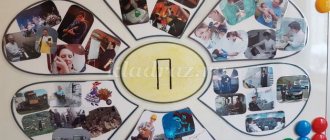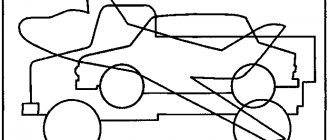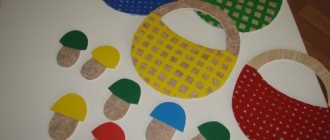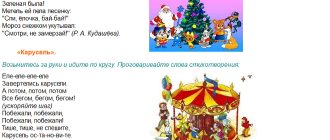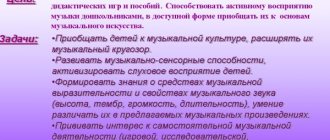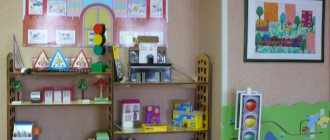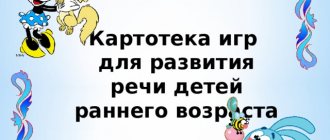Lapbook "Transport"
A laptop on the topic “Transport” is intended for children in the middle, high school and preparatory school groups. It will also be interesting for younger schoolchildren, and expand children’s knowledge of cognitive development.
Goal: To consolidate children's knowledge about different types of transport.
The first spread contains pictures depicting roads, rails, clouds, water and pockets with modes of transport: air, water, land, rail.
Didactic game “Arrange correctly”
Goal: To consolidate children's knowledge about types of transport.
Children's task: it is necessary to place pictures depicting different types of transport in the places where they move (ground - road, water - water, air - clouds, rail - rails).
Didactic game “Who controls what?”
Goal: To consolidate children's knowledge about professions.
Children's task: it is necessary to place images of a person in a work suit in the pocket with the transport he controls (driver - rail transport, captain - water transport, pilot - air transport, driver - ground transport).
The second spread contains information about parts of transport, the history of transport development, and types of special-purpose transport.
Didactic game “Parts of transport”
Goal: To consolidate children's knowledge about parts of transport
Children's task : you need to look at a card with a picture of transport and name the parts of transport that it consists of.
Little book “History of transport development”
Goal: To consolidate children’s knowledge about the history of transport development
This little book contains information about the history of the development of land transport (from a horse-drawn carriage to a modern car), about the history of the development of air transport (from the wings of Icarus to a modern airplane), about the history of the development of water transport (from a raft to a modern ship)
Didactic game "Special transport"
Goal: To consolidate children’s knowledge about special transport, professions, and the call number for special transport.
Children's task: it is necessary to place call numbers for special transport with the image of the special transport that will come to this call, to place pictures with the image of a person of the required profession on the transport in which they will come to help.
The third spread contains information about freight and passenger transport and the game “Help the Car”
Didactic game “Freight and passenger transport”
Goal: To consolidate children's knowledge about freight and passenger transport
Children's task: it is necessary to distribute passengers into the bus, cargo into the truck.
Didactic game “Help the car”
Goal: to consolidate children’s knowledge about car repair and car services
Children's task: you need to select pictures - the car has run out of gas - gas station, the car has a broken wheel - tire service, the car has broken down - car service.
Nomination: didactic games for preschoolers. Author: Demina Elena Mikhailovna Position: teacher of the 1st qualification category Place of work: MKDOU - Chernakovsky kindergarten "Teremok" Location: Chernakovo village, Ordynsky district, Novosibirsk region
Date modified: April 21, 2022 Date published: December 15, 2017
Thematic folder-lapbook “Road Rules”
Bibliographic description:
Markova, A. E. Thematic folder-lapbook “Road Rules” / A. E. Markova, T. A. Kireeva. — Text: direct // Education and upbringing. - 2022. - No. 5 (31). — P. 10-12. — URL: https://moluch.ru/th/4/archive/181/5748/ (access date: 01/18/2022).
Child safety is a serious issue. Introducing children to the alphabet of the road and developing their skills for correct behavior on the road must begin from a very early age, before the child adopts and accepts incorrect stereotypes of behavior on the road, which, unfortunately, are currently prevalent in the adult environment. The didactic lapbook manual “Road Rules” is intended for young children. This manual is a means of developmental learning and involves the use of modern technologies: technologies for organizing collective creative activities, social and communication technologies, gaming technologies. The lapbook “ Road Rules ” presents educational game material for use in joint and independent activities with young children for individual lessons, lessons in pairs and a small subgroup.
Let's illustrate this in Fig. 1
Rice. 1. Lepbook “Road Rules”
Goals: - formation in young children of elementary ideas about safe behavior on the roads through play activities;
– familiarizing children with traffic lights (teaching them to follow the requirements of the signals: red, yellow - stand, green - walk) and pedestrian crossings;
– familiarization with the concepts of “street”, “roadway”, “sidewalk”, “driver”, “traffic light”;
– formation in children of ideas about the rules of behavior on the roadway;
– develop observation, independent thinking, and attentiveness on the roads.
Objectives: Educational:
– introduce young children to basic traffic rules;
– to form initial ideas about the rules of conduct on the street, road, and in transport;
– to intensify efforts to prevent violations of traffic rules and a safe lifestyle among parents of pupils; — to enrich the developing subject-spatial environment of the group for organizing gaming activities with attributes, the “Road” layout for familiarization and reinforcement of traffic rules.
Educational:
– develop caution, attentiveness, independence, responsibility and prudence on the road;
– stimulate cognitive activity, promote the development of communication skills;
– promote the development of children’s speech, replenish children’s active and passive vocabulary, and develop coherent speech.
Educational:
– develop personal safety skills for future pedestrians;
– develop the ability to apply acquired knowledge in everyday life.
Age: 2.5–3 years
The lapbook contains materials about traffic rules for educational activities with young children.
It includes 11 developmental tasks:
- Pocket “Transport (introduction to special transport).”
Goal: to teach children to distinguish special vehicles, to find out what benefits they bring to people.
- Pocket “Transport (passenger)”
Introduction to passenger transport. This section is located on the left turn of the folder; pictures depicting passenger vehicles are selected. Purpose: to clarify ideas about transport and traffic rules; activate the processes of thinking, attention and speech of children; cultivate intelligence and resourcefulness, find differences from freight transport.
- Pocket "Road signs"
This section is located on the left side of the folder at the bottom and represents a pocket in which there are cards with images of road signs. Goals :
– Fix the names and purpose of road signs.
– Be able to determine which signs are for drivers and which are for pedestrians.
– To develop attention and skills of conscious use of knowledge about road signs in everyday life.
- Pocket "Transport (cargo)". Introduction to freight transport. This section is located on the left turn of the folder; pictures depicting freight transport are selected. Purpose: to clarify ideas about transport and traffic rules; activate the processes of thinking, attention and speech of children; cultivate intelligence and resourcefulness, find differences from passenger vehicles.
- Pedestrian pocket. This section is located on the central spread of the folder at the top; pictures depicting pedestrians are selected. Purpose: to clarify ideas about pedestrians and traffic rules; activate the processes of thinking, attention and speech of children; cultivate intelligence and resourcefulness, clarify who are road users. Material: pictures of animals, children, adults.
- Pocket "Rules (possible)". “Road rules for kids in pictures.” Cards have been selected showing the traffic situation and how to behave on the road. Objectives: consolidation and systematization of children’s knowledge about traffic rules and their purpose. Forming an idea of the meaning of traffic rules. Development of visual perception, attention. Materials: 20 green cards with correct traffic situations on the road.
- Pocket "Rules (not allowed)." “Road rules for kids in pictures.” Cards have been selected showing the traffic situation and how not to behave on the road. Materials: 20 red cards with incorrect traffic situations on the road.
- Pocket "Poems". This section features a pocket where there are cards with poems that explain the rules of the road to children in a fun way. Goal: learning the rules of the road in an entertaining way, developing memory. Materials: cards with poems.
- Pocket “Collect sign (pedestrian crossing).” Didactic game “Cut-out pictures “Assemble a road sign.” Objectives: consolidation and systematization of children’s knowledge about traffic signs and their purpose. Strengthening the ability to recognize and name road signs by appearance. Formation of an idea about the meaning of road signs and the organization of traffic, classification of road signs; conscious skills of behavior on city streets. Development of mental abilities, visual perception, attention, speech, fine motor skills of the hands. Materials: cut pictures from 4 parts.
- Pocket “Assemble the picture” (puzzles). This section represents a pocket in which parts of a cut picture are located. Goal: development of intelligence, visual attention, expansion of vocabulary, development of grammatically correct coherent speech. Assignment: correctly assemble a cut-out picture and examine it.
- Pocket "Riddles". Objectives: consolidation and systematization of children’s knowledge about traffic signs and their purpose. Strengthening the ability to recognize and name road signs by appearance. Formation of an idea about the meaning of road signs in the general system of traffic management, classification of road signs. Memory and speech training. Materials: cards with riddles, with images of traffic signs.
- "Traffic light". Located on the right spread at the top of the folder. Goal: to consolidate children’s ideas about the purpose of a traffic light, about its signals, to develop attention and visual perception. Didactic game "Traffic Light". Objectives: to introduce children to the rules of the road in a playful way. To form children’s ideas about the purpose of a traffic light, about its signals, to develop attention and visual perception.
Recommendations for use. The didactic manual - the lapbook "Road Rules" is recommended for use by preschool teachers in individual work with children, in independent and play activities. Thanks to this form of work, children learn a lot about traffic rules, know and enjoy listening to poems about road signs, and discuss the meaning of road signs. situations regarding traffic rules, guess riddles about traffic rules, know the rules of the road. Working with a lapbook made it possible to diversify the work and increased the cognitive interest of children.
Why did we choose the form - lapbook? A laptop is a new form of organizing educational activities for the development of children’s cognitive activity and the development of independence. It helps the child, at will, to obtain information on the topic being studied and to better understand and remember the material. This is a great way to review what you've learned. At any convenient time, the child simply opens the laptop and happily plays and looks at the book he made with his own hands. The laptop is well suited for classes in subgroups where several children will be busy at the same time. You can choose tasks that everyone can do (for some, pockets with cards or figures on a given topic, and for other children, tasks that involve the development of logical thinking). Creating a lapbook is just fun!
Literature:
1. Saulina T. F. “Three traffic lights” - M.: Education, 2015.
- Pikuleva N. “Road ABC.” — M: Strekoza-Press, 2005
3. Khabibullina E. Ya. “Road alphabet in kindergarten.” - S.-P.: Detstvo-press, 2011
Psychological mirror
The “Transport” laptop contains more than 13 games and tasks aimed at developing a child’s thinking, memory, attention, and speech. With the help of a lapbook, the child will learn to classify vehicles into various categories (by type (air, land, water transport), by the number of wheels, by color...) 1. “Game “Paired Pictures”
Objectives :
development of visual memory and attention of children.
Materials
: 6 pairs of cards with images of vehicles
Number of players:
2-3 players
Game rules .
All cards are placed face down and shuffled.
Players take turns picking up any 2 cards: if the images are the same, the player takes the cards for himself, if not, he puts them in the same places. The player who collects the most pairs wins. 2. Lotto “Who will ride what?” Objectives :
developing children's thinking, expanding their understanding of the various types of transport needed by people of various professions.
Materials
: 4 game boards, set of 12 vehicle cards.
Number of players:
2-4 players
Game rules .
Each player takes 1 game board.
Transport cards are shuffled and placed in a pile. The presenter picks up cards from the deck one by one, naming the vehicle. The player who has a picture of a person moving on this vehicle takes the card for himself, covering the empty field. The person who fills out their entire card(s) the fastest wins. 3. "The fourth wheel." Objectives :
developing children's thinking, learning to find the odd one out based on various criteria (category, color)
Materials
: 5 task cards, 4 drawings.
The cards can be cut, folded like an accordion, or left as a sheet and inserted into a file. The second copy of the cards is cut to create your own tasks, which you can ask each other in turn. Exercise .
Find an extra item in each row.
In the first row there is an extra non-air vehicle - a motorcycle; in the second row there is an extra ship - not a land transport; in the third task, the extra plane is not water transport; in the fourth there is an extra car, because it does not apply to special equipment; in the fifth there is a helicopter, because it is not red. 4. Classification “Flies, swims, drives” Objectives :
developing children’s thinking, expanding their understanding of various types of transport and their types: water, land, air.
Materials
: cards from the game “4 extra” are printed for this game again, cut into separate cards.
Field – drawing of a city with a road and sea. Exercise .
Arrange the cards according to the mode of transport in the appropriate fields of the picture.
Name generalizing words. 5. “Make a story” Objectives :
development of coherent speech, fantasy and imagination of the child.
Materials
: field and cards of the game “Flies, swims, drives.”
Number of players:
any
Rules of the game .
Cards with cut transport are placed face down in a pile.
The first player does not look at the vehicle and places it on any part of the field (in the air, on the road, on the house...) The second player turns over the card and must explain, come up with why or how this vehicle ended up here. Then, for the next player, without looking at the transport, he places a field, etc. 6. Game “Confusion” Objectives :
development of children’s thinking.
Materials
: field and cards of the game “Flies, swims, drives.”
Number of players:
unlimited.
Rules of the game .
An adult or child classifies transport according to air, water, land and deliberately makes a mistake.
The child’s task is to find this mistake. 7. Game “What has changed” Objectives :
development of children’s visual memory.
Materials
: field and cards of the game “Flies, swims, drives” or cards of the game “Find the shadow”
Number of players:
2 players
Rules of the game .
4-5 cards are laid out in front of the child, he remembers them and turns away.
The task of the adult (other child) is to make changes. These can be the following tasks: – change the sequence of pictures (swap 2 cards), – replace one of them with another from the same set, – remove one of the pictures. The first player must guess what has changed. The game can be made more difficult by increasing the number of objects to remember. 8. Classification “Wheels” Objectives :
development of children’s thinking, learning to classify objects according to various criteria (number of wheels)
Materials
: field “Continue the row” with the image on the first card of the number of wheels: six, none, caterpillars, four.”.
Task .
Arrange the cards of the game “Find the Shadow” in these groups, based on the number of wheels.
9. Cut-out pictures “Transport” Objectives :
development of children’s perception, recreating imagination, imaginative thinking.
Materials
: pictures of transport, cut into 4 or more parts.
Number of players:
according to the number of cards.
Rules of the game .
Collect the cut picture.
If several children are playing, you can collect pictures at speed. 10. Game “Find the shadow” Objectives :
development of attention, observation of shape perception.
Materials
: a field with images of shadows of various vehicles and 18 cards with their drawings.
Number of players:
2-3 players
Rules of the game .
The cards are cut, shuffled and placed face down.
Players take turns opening one card at a time. The speed task is to find the shadow of this vehicle. The one who did it first takes the picture for himself. If several players show a shadow at the same time, the card is shuffled back into the deck. The player with the most pictures wins. 11. Riddles “Guess the Transport” Objectives :
developing children’s thinking, expanding their understanding of various types of transport.
Materials
: book with riddles.
12. Poems about vehicles Objectives :
development of coherent speech and child’s memory.
Materials
: book with poems.
13. Game “Assemble transport” Objectives :
development of children’s thinking and perception.
Materials
: a book with pages cut into 2 parts.
The book is glued in the wrong order (top and bottom on another vehicle). Number of players:
one.
Rules of the game .
Leafing through the book, you need to select the top and bottom so as to assemble the vehicle.
14. Learning to draw. Transport. Objectives :
development of hand motor skills, perception, development of the ability to draw cars.
Materials: 14
diagrams with step-by-step drawing of vehicles.
You can purchase a Lapbook in the store or using the built-in payment system [rk_button sku=”Lot No. M 06″ description=”Lapbook Transport” price=”250 RUR”]
Views 322, Today 3

